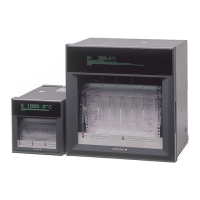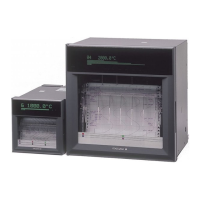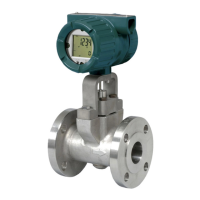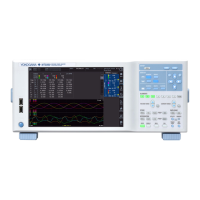9-5
IM 04P01B01-01E
Operations Related to the Computation Function (/M1 Option)
9.2 Setting the Computing Equation
9
• Status of the Remote Control Input Terminal (D01 to D05, /R1 option)
The status of the remote control input signal (1 or 0) can be used in the computation.
Use D01 to D05 (the number following the letter D is the remote control input terminal
number) to specify the status in the equations.
Four Arithmetic Operation
The data that can be used in equations are measured values, computed values,
constants, communication input data, and remote control input terminal status.
Equation Examples
• Addition 01+02
(Determines the sum of the measured values of channel 1 and channel
2.)
• Subtraction 01–02
(Determinesthedierenceofthemeasuredvaluesofchannel1and
channel 2.)
• Multiplication 01*K03
(Multiplies constant K03 to the measured value of channel 1.)
• Division 01/K02
(Divides the measured value of channel 1 by constant K02.)
Note
By setting an equation similar to the one shown below, you can determine the accumulation
of a specified channel (in this case channel 01) and make the result the computed value of
computation channel 0A.
Computing equation of computation channel 0A: 0A+01
Power and Other Computations
The data that can be used in equations are measured values, computed values,
constants, communication input data, and remote control input terminal status. You can
nest a computing element inside the parentheses of another computing element.
Equation Examples
• Power 01**02
(Determines the measured value of channel 1 to the power of
the measured value of channel 2.)
• Square root SQR(02)
(Determines the square root of the measured value of channel
2.)
• Absolute value ABS(02)
(Determines the absolute value of the measured value of
channel 2.)
• Common logarithm LOG(01)
(Determines the common logarithm (log
10
) of the measured
value of channel 1.)
• Exponent EXP(01)
(Determines e to the power of the measured value of channel 1.)
Note
You can determine the natural logarithm by setting an equation like the following.
From log
b
X = log
a
X/log
a
, we obtain log
e
X = log
10
X/log
10
e
Hence, to determine the natural logarithm of channel 1, we set
Constant K01 = 0.43429(log
10
e), and
Computing equation LOG(01)/K01.

